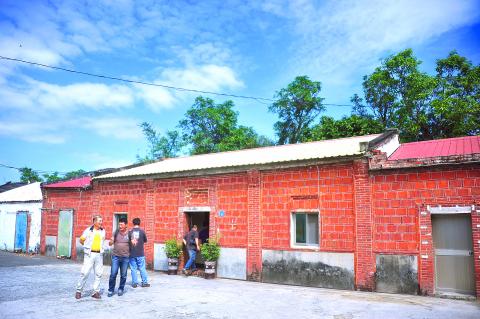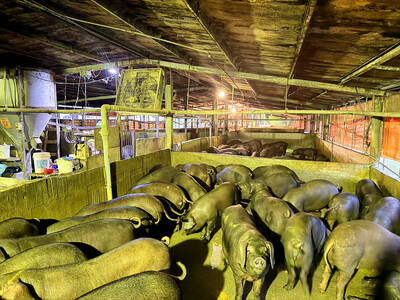The historic 130-year-old Chang mansion in Hengchun’s Beimen area was diligently maintained by a descendent of the family, Chang Wei-chi. Pingtung County Cultural Affairs Department head Wu Chin-fa and many members of the cultural heritage committee went to survey the Chang mansion and were left deeply impressed by the old well and the red tile walls of the house.
The site of the historic Chang mansion at Beimen dates from the Qing Dynasty, and includes the original Qing Dynasty site, the extension built during the Japanese colonial period and the post- retrocession extension. Chang’s descendants hope that in the future the post-retrocession part of the building will be demolished and the Qing part and the Japanese colonial era extension will be maintained. They also hope that the cultural vista of the bamboo moat and courtyard doors can be restored, creating the traditional appearance of a Hengchun style house.
Chang pointed out that portions of the site of the mansion overlap with land which is to be re-developed. The ownership of the house was complex, thus it was difficult to maintain it. He said he had the rights from the majority of owners of the house and hoped that the county would recognize it as a historic building as soon as possible.

Photo: Tsai Chong-Hsien, Liberty Times
照片:自由時報蔡宗憲
Pingtung County councilor Chang Rong-chih who is also head of the Chang clan said the Chang ancestral house is precious and the spirit displayed by young people returning to their hometown to maintain their property was moving. The older Chang generation were glad of their assistance, said Chang.
After the survey, Wu said that the well, the bamboo moat and the house itself had the beauty of an old mansion, and supported the Chang clan diligently seeking to have the house classified as a historic building. However, he said the cultural assets would still be considered in accordance with the provisions of the cultural heritage committee.
(Liberty Times, translated by Clare Lear)
一百三十多年歷史的恆春北門張家祖厝,經後代子孫張洧齊努力爭取保存,屏東縣文化處長吳錦發及多名文資委員到張家古厝會勘,對古厝的水井、斗子牆印象深刻。
歷史悠久的北門張家古厝包括清朝古厝地、日治擴建部分、光復後擴建部等時期,張家子孫希望未來將拆除光復後擴建部分,保留清朝現址與日治擴建部分,並還原竹塹與門埕之文化景觀,營造恆春傳統民宅風貌。
張洧齊指出,祖厝土地與附近土地重建部分重疊,加上古厝所有權人複雜,保存困難,目前已經取得古厝多數所有權人授權,期待縣府盡快確認為歷史建築。
身兼恆春張氏宗親會理事長的屏東縣議員張榮志說,張氏祖厝相當珍貴,返鄉年輕人保留家鄉資產的精神令人感動,張氏耆老們將鼎力協助這樁美事。
吳錦發會勘後表示,當地的水井、竹塹及建築本體都很有老厝之美,也認同張家子孫爭取為歷史建築的用心,但依規定仍須由文化資產審議委員會審議。
(自由時報記者蔡宗憲)

For many people in Taiwan, childhood memories of rural life include pig pens standing beside family homes. Leftover rice, vegetable scraps and soup from daily meals were poured into buckets and fed to pigs. This practice of feeding pigs with household food waste was once a common way of life, both an economic choice and an expression of agricultural society’s deep respect for conserving resources. From a practical standpoint, pigs are omnivorous animals capable of efficiently digesting food scraps that humans can no longer eat. For rural households, food waste cost almost nothing, yet it could be converted into pork, a

A: Apart from the Taipei Music Center’s exhibit and concert, US pop rock band OneRepublic and rapper Doja Cat are touring Kaohsiung this weekend. B: OneRepublic is so popular that after tonight’s show at the K-Arena, they are set to return to Taiwan again in March next year. A: And Doja will also perform at the same venue on Sunday, right? B: Yup. Her collab with Blackpink’s Lisa and singer Raye for the song “Born Again” has been a huge worldwide success. A: Doja even made it on Time magazine’s “100 Most Influential People” list in 2023. She’s so cool. A: 本週末除了北流的特展和演唱會外,美國男團共和世代和饒舌歌手蜜桃貓朵佳也將來台開唱。 B: 共和世代因太受歡迎,繼今晚高雄巨蛋的演唱會後,預計明年3月即將再度來台巡演唷。 A: 朵佳本週日將在同場地開唱,對不對?

Tango unfolds in a dimly lit room, where a haunting melody ushers two dancers into a close embrace. Here, music and movement merge into a silent yet passionate conversation, expressing longing, memory and shared purpose. What makes tango truly magical is the deep interaction and spontaneous improvisation between partners. Tango began in the late 19th century in Buenos Aires, Argentina’s bustling capital. Born in the poor working-class neighborhoods and busy port areas, this dance emerged from a melting pot of cultures. European immigrants, African slaves and local residents all contributed to its unique character. From these rich influences, tango

A: What show are you watching online? B: I’m watching “Fly Me to the Moon & Back” – an exhibition launched by the Taipei Music Center (TMC) to commemorate the late singer Tom Chang. A: Known for his sky-high notes, Chang is praised as one of the best singers in the 1990s. His death at the age of 31 was a major loss indeed. B: And I’m so glad that we went to the TMC’s 90s-themed concert last Friday. I finally saw the iconic “Godmother of Rock” WaWa perform live. A: This year-end show also featured singers Princess Ai, Bii, Wayne Huang, PoLin and